Recommended Hardware
| Grade of Bolt | Surface Finish | Nominal Size Inches | Recommended ASTM Nut Grade & ANSI Style | Washer | |
| Hex | Heavy Hex | ||||
| F1554 Grade 36 | Any | 1/2 to 1-1/2 | A563A | F436 | |
| 1-5/8 to 4 | A563A | ||||
| F1554 Grade 55 | Plain | 1/2 to 1-1/2 | A563A | F436 | |
| 1-5/8 to 4 | A563A | ||||
| Galvanized | 1/2 to 1-1/2 | A563A | F436 | ||
| 1-5/8 to 4 | |||||
| F1554 Grade 105 | Plain | 1/2 to 1-1/2 | A563D | F436 | |
| 1-5/8 to 3 | A563DH | ||||
| Galvanized | 1/2 to 1-1/2 | A563DH | F436 | ||
| 1-5/8 to 3 | |||||
| A307 Grade A | Any | 1/4 to 1-1/2 | A563A | F436 | |
| >1-1/2 to 2 | A563A | ||||
| >2 to 4 | |||||
| A307 Grade B | Any | 1/4 to 1-1/2 | A563A | F436 | |
| >1-1/2 to 2 | |||||
| >2 to 4 | |||||
| A449 | Plain | 1/4 to 1-1/2 | A563B | F436 | |
| >1-1/2 to 3 | A563A | ||||
| Galvanized | 1/4 to 1-1/2 | A563DH | F436 | ||
| >1-1/2 to 3 | A563DH | ||||
| A354 Grade BC | Plain | 1/4 to 1-1/2 | A563C | F436 | |
| >1-1/2 to 4 | |||||
| Galvanized | 1/4 to 1-1/2 | A563DH | F436 | ||
| >1-1/2 to 4 | |||||
| A354 Grade BD | Plain | 1/4 to 1-1/2 | A563DH | F436 | |
| >1-1/2 to 4 | |||||
| A193 Grade B7 | Any | 1/4 to 7 | A194 2H or 4 or 7 | F436 | |
| A193 Grade B8 | All | A194 Grade 8 | SS304 | ||
| A193 Grade B8M | All | A194 Grade 8M | SS316 | ||
| A320 Grade L7 | Any | 1/4 to 2-1/2 | A194 Grade 4 or 7 | F436 | |
| A320 Grade L43 | Any | 1/4 to 4 | A194 Grade 4 or 7 | F436 | |
| A320 Grade B8 | All | A194 Grade 8 | SS304 | ||
| A320 Grade B8M | All | A194 Grade 8M | SS316 | ||
| F593 | All | F594 | SS304 or SS316 | ||
Nuts
ASTM A563 Hex and Heavy Hex Nuts
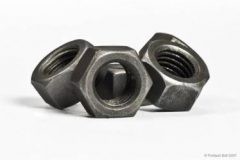 The ASTM A563 specification covers the chemical and mechanical requirements for carbon and alloy steel nuts. According to the A563 specification, “The requirements for any grade of nut may, at the supplier’s option, and with notice to the purchaser, be fulfilled by furnishing nuts of one of the stronger grades specified herein unless such a substitution is barred in the inquiry and purchase order”. This is important because some nut grades are not readily available in certain sizes and finishes. Additionally, the specification allows for the substitution of ASTM A194 grade 2H nuts in lieu of A563 grade DH nuts due to the lack of availability of grade DH nuts in nominal sizes 3/4″ and larger. Hot-dip galvanized nuts must be tapped oversize to allow for the added thickness of the zinc on the threads of the externally threaded fastener.
The ASTM A563 specification covers the chemical and mechanical requirements for carbon and alloy steel nuts. According to the A563 specification, “The requirements for any grade of nut may, at the supplier’s option, and with notice to the purchaser, be fulfilled by furnishing nuts of one of the stronger grades specified herein unless such a substitution is barred in the inquiry and purchase order”. This is important because some nut grades are not readily available in certain sizes and finishes. Additionally, the specification allows for the substitution of ASTM A194 grade 2H nuts in lieu of A563 grade DH nuts due to the lack of availability of grade DH nuts in nominal sizes 3/4″ and larger. Hot-dip galvanized nuts must be tapped oversize to allow for the added thickness of the zinc on the threads of the externally threaded fastener.
A194 Heavy Hex Nuts
The ASTM A194 specification covers carbon, alloy and stainless steel nuts intended for use in high-pressure and/or high-temperature service. Unless otherwise specified, the American National Standard Heavy Hex Series (ANSI B 18.2.2) shall be used. Nuts up to and including 1-inch nominal size shall be UNC Series Class 2B fit. Nuts over 1-inch nominal size shall be either UNC Series Class 2B fit or 8 UN Series Class 2B fit. High strength ASTM A194 grade 2H nuts are common in the marketplace and are often substituted for ASTM A563 grade DH nuts due to the limited availability of DH nuts in certain diameters and finishes.
ASTM F594 Hex Nuts
ASTM F594 covers the chemical and mechanical requirements for stainless steel nuts in diameters ranging from 1/4″ to 1-1/2″ inclusive and are used with fasteners conforming to ASTM F593. These nuts are for general purpose applications and are available in seven alloy groups. The two most common are Alloy Group 1 (type 304 stainless) and Alloy Group 2 (type 316 stainless).
Washers
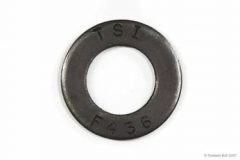 ASTM F436
ASTM F436
These washers are through hardened or carburized to add strength and are the recommended washer for all anchor rods.
Plates
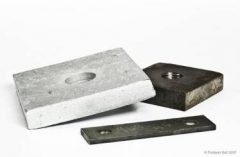 Anchor rods are often used with square and rectangular plates. These can be used on either end, but they are most commonly used on the embedded end. This creates a larger bearing surface to reduce the risk of the rod pulling out of the foundation. The two most common grades of square plates are ASTM A36 and A572 Grade 50. Large plates with multiple holes can also be used as templates to provide proper spacing of the anchor rods.
Anchor rods are often used with square and rectangular plates. These can be used on either end, but they are most commonly used on the embedded end. This creates a larger bearing surface to reduce the risk of the rod pulling out of the foundation. The two most common grades of square plates are ASTM A36 and A572 Grade 50. Large plates with multiple holes can also be used as templates to provide proper spacing of the anchor rods.
Anchor Sleeves
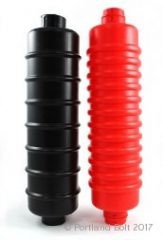 Anchor sleeves are often used as a way of assisting in the alignment of an anchor rod so that the structure or equipment can be installed with ease. Anchor sleeves create a cavity in the concrete where the anchor bolt can be adjusted in the case that an anchor bolt is slightly out of alignment and needs to be adjusted to fit the equipment. After aligned correctly, the cavity is then filled with grout. An engineer may also specify a custom sleeve that consists of a steel pipe that is welded to an anchor rod or anchor rod embed plate, which are more of a custom item.
Anchor sleeves are often used as a way of assisting in the alignment of an anchor rod so that the structure or equipment can be installed with ease. Anchor sleeves create a cavity in the concrete where the anchor bolt can be adjusted in the case that an anchor bolt is slightly out of alignment and needs to be adjusted to fit the equipment. After aligned correctly, the cavity is then filled with grout. An engineer may also specify a custom sleeve that consists of a steel pipe that is welded to an anchor rod or anchor rod embed plate, which are more of a custom item.
Hex Coupling Nuts
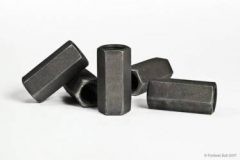 Hex coupling nuts have right hand threads and are used to connect two threaded fasteners. A standard coupling nut length is three times the rod diameter. Some coupling nuts that are mass-produced are slightly shorter however, longer coupling nuts can be custom made. A common use for coupling nuts is when an anchor rod has been set too low, a way to extend them would be to assemble a coupling nut on the projecting end of the set anchor rod and install a rod into the opposite end of the coupling nut. Typically, the extending rod used is fully threaded and would be the same ASTM grade as the set anchor rod.
Hex coupling nuts have right hand threads and are used to connect two threaded fasteners. A standard coupling nut length is three times the rod diameter. Some coupling nuts that are mass-produced are slightly shorter however, longer coupling nuts can be custom made. A common use for coupling nuts is when an anchor rod has been set too low, a way to extend them would be to assemble a coupling nut on the projecting end of the set anchor rod and install a rod into the opposite end of the coupling nut. Typically, the extending rod used is fully threaded and would be the same ASTM grade as the set anchor rod.
Although there isn’t any published information specifying what grade of coupling nut should be used, it is common practice to use a coupling nut that is specified to the same grade as the compatible nut, or higher. In other words, if the embedded anchor rod is F1554 Grade 36, an A563A hex coupling nut should work, however A563DH or A194 2H heavy hex coupling nuts should be an acceptable substitute, assuming they aren’t being welded. Either way, it is always a good idea to consult an engineer in this type of scenario.
